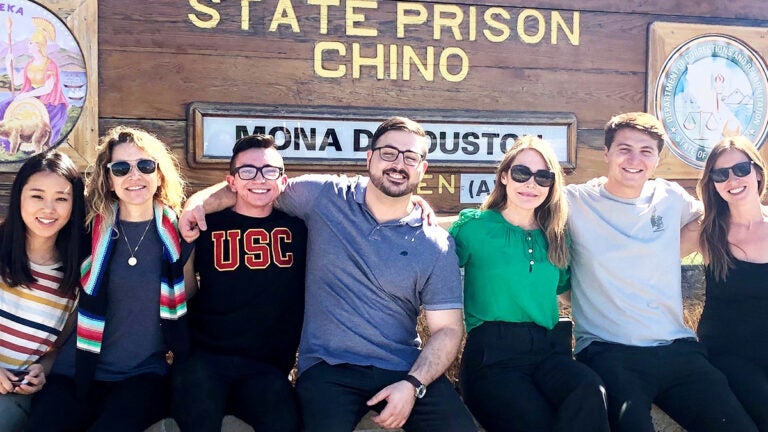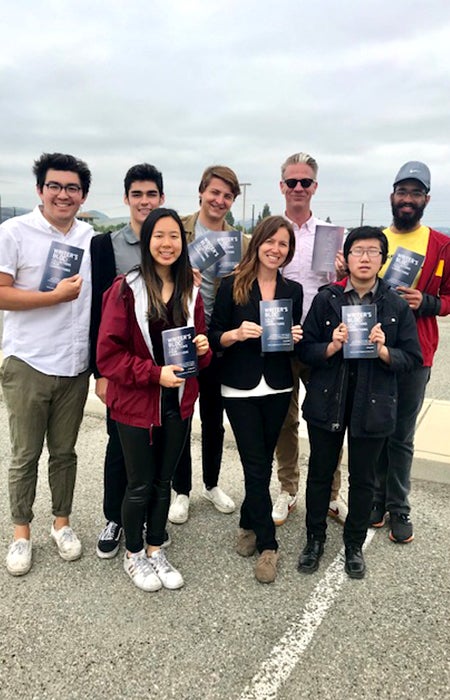
Prison Education Project brings poetry, philosophy and physics to the incarcerated
Prison may not seem the best place to teach university-level classes, but to the surprise of instructors in the Prison Education Project (PEP) at the USC Dornsife College of Letters, Arts and Sciences, the venue has proven to be ideal. With no computers, phones or internet access, the classroom environment harkens back to a simpler time in education.
“We’re present with one another in a way that I don’t find in my other classrooms. No one’s checking their phone,” says PEP Co-director Nik De Dominic, assistant professor (teaching) of writing. “The men and women that are coming to those classrooms are really happy to be there.”
Since 2018, PEP has brought classes on subjects including film, biology and writing to prisons around the state, including the California Rehabilitation Center in Norco and the Santa Fe Springs women’s prison. USC Dornsife students volunteer in the classes as teaching assistants and answer prisoners’ questions about college life.
In exchange for attending PEP classes, some prisons offer their participating students a reduction in sentence, but that isn’t a prisoner’s only motivation to enroll.
“Many of our incarcerated students have told us time and time again, ‘In this class I feel free. I feel like I can be human. Elsewhere in the prison, I have to keep my guard up, but here I can finally relax a little bit and be vulnerable,’” says Kate Levin, co-director of PEP and assistant professor (teaching) of writing.
Talent behind bars

When De Dominic arrived at USC Dornsife in 2015, he was surprised to discover that the university did not offer a prison education program for those currently incarcerated. He’d previously been an Alabama Prison Arts + Education fellow at the University of Alabama and had also taught in prisons in New Orleans.
He partnered with Levin who shared his interest in starting a program for the imprisoned. The two teamed up with the Prison Education Project, founded by Renford Reese, professor of political science at California State Polytechnic University, Pomona, which connects them with prisons and arranges for classes to take place.
In the spring of 2018, at the end of their first creative writing class at the California Rehabilitation Center at Norco, De Dominic and Levin created an anthology of their students’ writing. They arranged a reading, and the prison laid out refreshments. Students took turns standing up to read their work in what proved to be an emotional event.
“Honestly, there were so many tears. Nik and I were both bawling,” says Levin.
Navigating the enormous and elaborate prison bureaucracy is their biggest obstacle, says De Dominic. Sometimes, after driving an hour and a half from campus to a facility to teach, an unknown incident inside the prison means class is abruptly canceled.
Once inside the walls though, it’s worth all the effort. “We get in there every semester with [writing classes] and our students are producing work that we could very well see in the Kenyon Review,” says De Dominic, referring to the prestigious literary journal. “I feel incredibly proud of that.”
Each semester, De Dominic and Levin put out a call for volunteer faculty to teach courses with PEP. They usually get more interested participants than they can accommodate. They’ve hosted classes on ethics, physics and astronomy, sci-fi writing and much more.
Prisoner to prosperity pipeline
For those who balk at the thought of prisoners receiving free classes, Levin argues that PEP provides practical benefits to the larger community.
“Research shows that if someone in prison just takes one class, they’re far less likely to recidivate,” she says. It costs a little more than $80,000 to incarcerate an inmate for one year in California. If programs like PEP can present inmates from returning to the system, it could save taxpayers a considerable amount of cash.
Michelle Meyers, lecturer in writing, believes that her PEP creative writing classes give students emotional regulation skills, something many prisoners struggle with.
“One of the things that all people need in their lives are emotional outlets, ways to express and process feelings,” says Meyers. “[With writing], you get stuff out on paper that might be bothering you. It’s important to have job skills, but it’s also important to have skills in making it through the day.”
For USC student volunteers, it’s a chance to break out of their comfort zone and confront stereotypes. One volunteer in De Dominic and Levin’s first writing class penned an apology letter at the end of the course, stating that she’d started with the view of prisoners as “menacing thugs.”
“I am so grateful to this program for opening my eyes and giving me the opportunity to meet all of you,” reads her letter.
G Bajaj a health and human sciences major who is PEP’s student co-director, says working with the prison population has broadened his perspective as he studies towards becoming a physician.
“In order to be a good health professional, you have to understand the different facets of the community you’re serving,” he says. “If you can’t understand someone that’s experiencing homelessness or someone that’s formerly incarcerated, how do you expect to advocate for that patient?”
COVID-19 in the cells
The coronavirus pandemic has complicated PEP’s work. Prisons are experiencing serious outbreaks, which has delayed the start of PEP’s classes this semester and forced the work to become virtual. Many lectures must now be prerecorded.
In Meyers class, students meet over Zoom, using audio only. (Prison regulations forbid the use of video.) The whole class shares one computer. The specter of disease hangs over the group. Meyers generally asks her students to share a positive and a negative each week, or a “rose and thorn.” Pre-COVID, roses were typically about nearing the end of a sentence or working in the prison’s gardens. Now, a student’s rose might be that the ward had remained free of infections that week.
The PEP crew soldiers on with hopes of returning to in-person classes this summer, provided the county allows them back.
“Many things in the prison space are designed to strip people of their humanity,” says Levin. “If we can go there and help open up a little space where people can be human, why wouldn’t we want to keep doing that?”